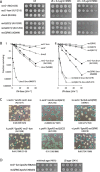Cellular location and activity of Escherichia coli RecG proteins shed light on the function of its structurally unresolved C-terminus
- PMID: 24692661
- PMCID: PMC4027168
- DOI: 10.1093/nar/gku228
Cellular location and activity of Escherichia coli RecG proteins shed light on the function of its structurally unresolved C-terminus
Abstract
RecG is a DNA translocase encoded by most species of bacteria. The Escherichia coli protein targets branched DNA substrates and drives the unwinding and rewinding of DNA strands. Its ability to remodel replication forks and to genetically interact with PriA protein have led to the idea that it plays an important role in securing faithful genome duplication. Here we report that RecG co-localises with sites of DNA replication and identify conserved arginine and tryptophan residues near its C-terminus that are needed for this localisation. We establish that the extreme C-terminus, which is not resolved in the crystal structure, is vital for DNA unwinding but not for DNA binding. Substituting an alanine for a highly conserved tyrosine near the very end results in a substantial reduction in the ability to unwind replication fork and Holliday junction structures but has no effect on substrate affinity. Deleting or substituting the terminal alanine causes an even greater reduction in unwinding activity, which is somewhat surprising as this residue is not uniformly present in closely related RecG proteins. More significantly, the extreme C-terminal mutations have little effect on localisation. Mutations that do prevent localisation result in only a slight reduction in the capacity for DNA repair.
© 2014 The Author(s). Published by Oxford University Press on behalf of Nucleic Acids Research.
Figures






References
-
- Rudolph C.J., Upton A.L., Briggs G.S., Lloyd R.G. Is RecG a general guardian of the bacterial genome? DNA Repair (Amst.) 2010;9:210–223. - PubMed
Publication types
MeSH terms
Substances
Grants and funding
LinkOut - more resources
Full Text Sources
Other Literature Sources

